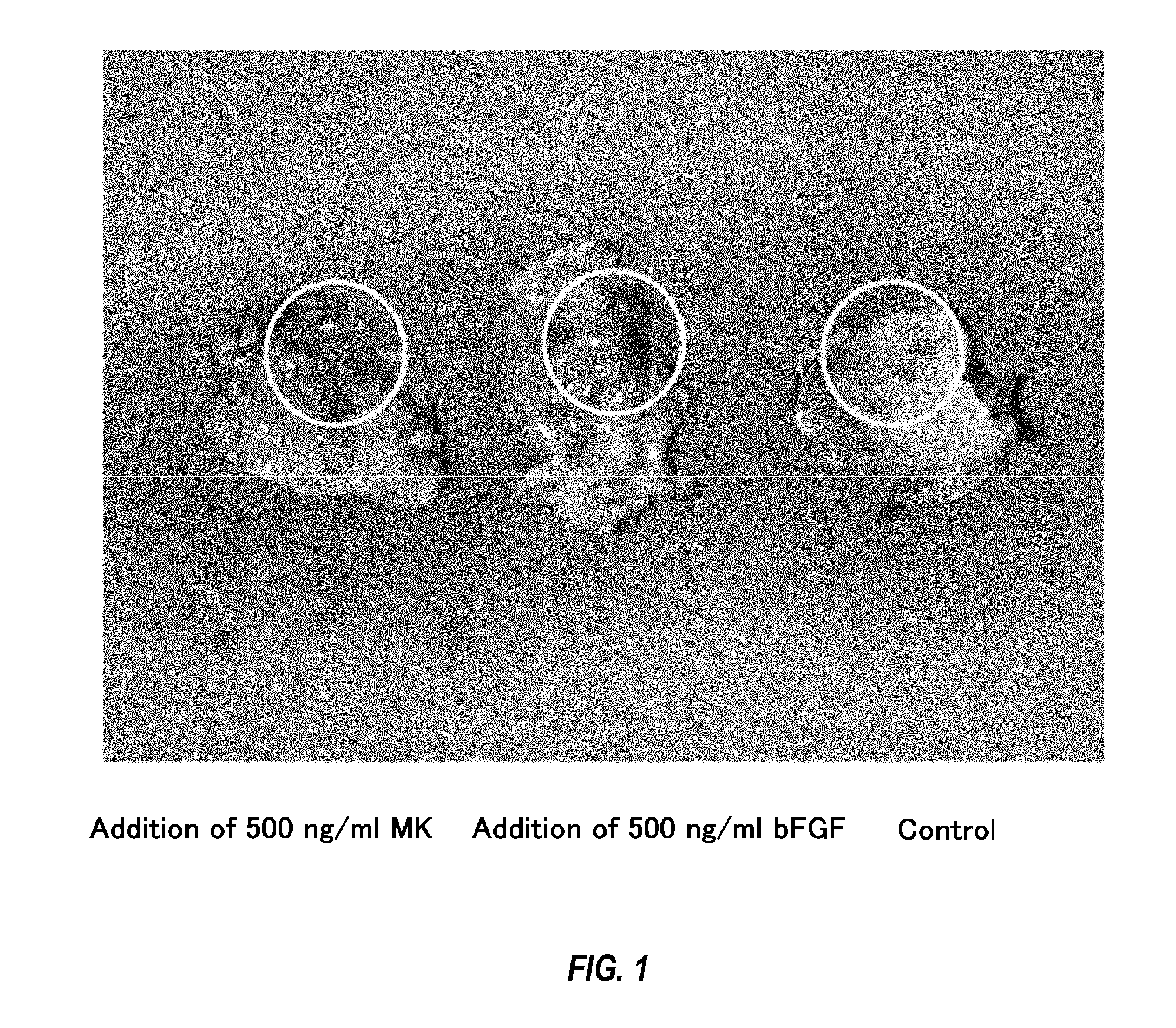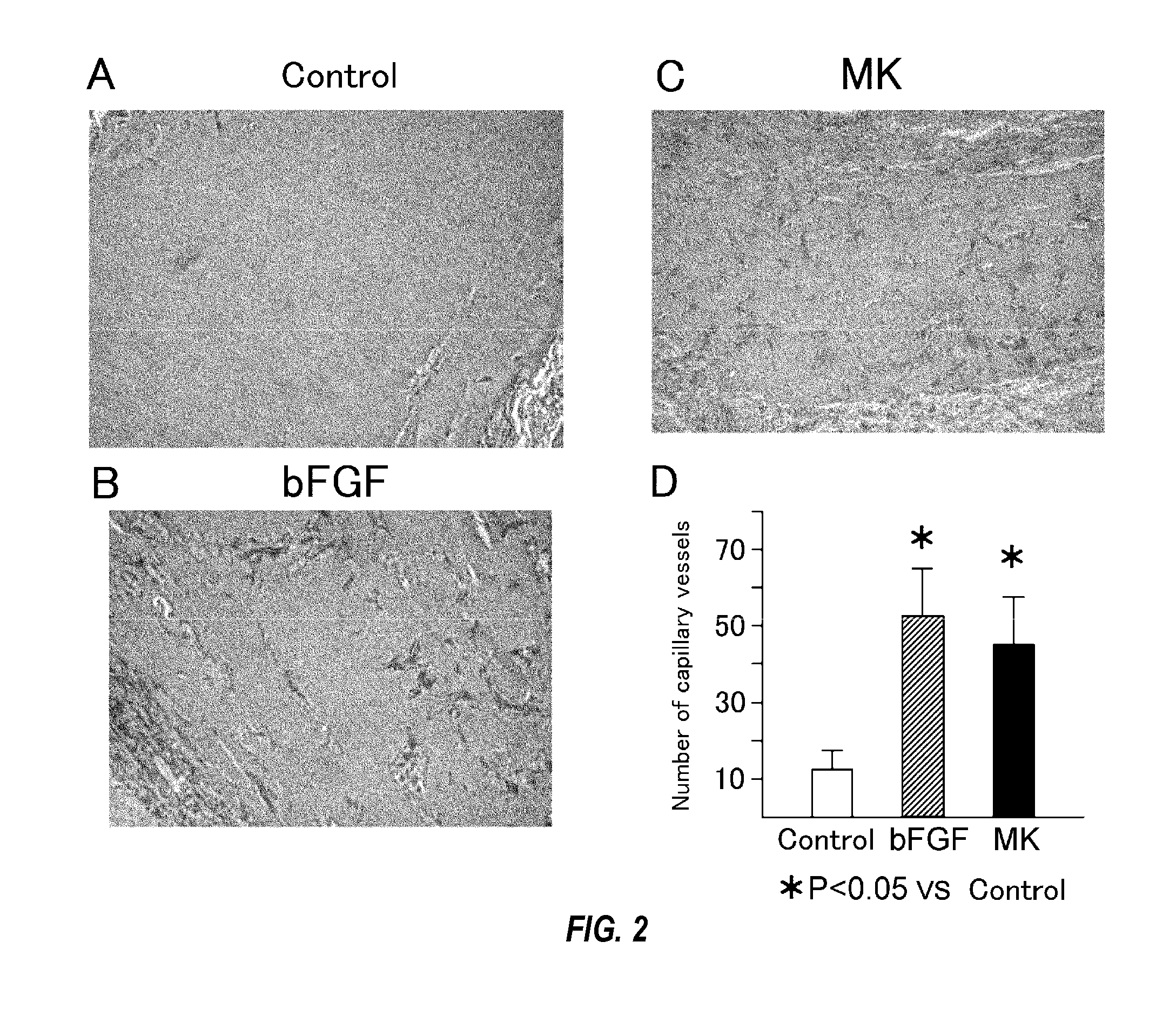Therapeutic agent for occlusive peripheral vascular disease, and use thereof
a peripheral vascular disease and therapeutic agent technology, applied in the direction of cardiovascular disorders, drug compositions, peptide/protein ingredients, etc., can solve the problems of poor prognosis, unreachable decisive therapeutic effects, and impaired quality of life, so as to improve the symptom promote angiogenesis, and improve the blood flow of the lower extremity
- Summary
- Abstract
- Description
- Claims
- Application Information
AI Technical Summary
Benefits of technology
Problems solved by technology
Method used
Image
Examples
example 1
Angiogenic Activity of Midkine
[0077]First, it was examined whether or not a growth factor midkine showed angiogenic activity.
[0078]Specifically, angiogenic activities were compared through subcutaneous matrigel injection of midkine into mice. The subcutaneous matrigel injection of midkine with a concentration of 500 ng / ml or angiogenesis factor bFGF (positive control) with a concentration of 500 ng / ml was carried out into mice to observe the angiogenic activity. HE (hematoxylin eosin) staining of the section of subcutaneous matrigel was carried out to measure the number of blood vessels.
[0079]As a result, the remarkable proliferation of the blood vessels by the addition of the midkine was observed in comparison with controls (FIG. 1). In addition, the number of blood vessels measured at 7 days after the administration exhibited a significant increase in the number of blood vessels compared to the controls receiving nothing (FIG. 2; 3.31±0.18 fold vs. controls, n=7, p<0.05) . All the...
example 2
Lumen Formation Activity of Midkine Subsequently, it was examined whether or not midkine had a lumen formation activity in cultured vascular endothelial cells.
[0080]Midkine at a concentration of 100 ng / ml was added to HUVECs (normal human umbilical vein endothelial cells), cultured on growth factor-deficient matrigel in the absence of blood serum for 6 hours, and its influence on lumen formation was observed.
[0081]As a result, the lumen formation was found to be promoted by the midkine, similarly as in case of the positive control bFGF (FIG. 3). These results have strongly corroborated that midkine has angiogenic activity.
example 3
Examination of Therapeutic Effect of Midkine in Lower Extremity Ischemic Disease Model Mice
[0082]Subsequently, the therapeutic effect of midkine was examined in lower extremity ischemic disease model mice. Specifically, the lower extremity ischemic disease model mice were produced, and the blood flow of the lower extremity was measured in each of the midkine-knockout and wild-type mice.
[0083]The midkine-knockout mice (Mdk− / − mice) that were bred by a method described in the Nakamura et al. (Genes Cells 3:811-822, 1998) were used. Both of the wild-type (Mdk+ / + mice) and midkine-knockout (Mdk− / − mice) mice had a genetic background of C57BL / 6. In addition, the mice of the same age were used in the study.
[0084]The lower extremity ischemic disease model mice were produced by removing the blood vessels from the femoral artery through the external iliac artery of each of the midkine-knockout mice (MKKO) and the wild-type mice (WT) as shown in FIG. 4.
[0085]The blood flow of the lower extrem...
PUM
 Login to View More
Login to View More Abstract
Description
Claims
Application Information
 Login to View More
Login to View More - R&D
- Intellectual Property
- Life Sciences
- Materials
- Tech Scout
- Unparalleled Data Quality
- Higher Quality Content
- 60% Fewer Hallucinations
Browse by: Latest US Patents, China's latest patents, Technical Efficacy Thesaurus, Application Domain, Technology Topic, Popular Technical Reports.
© 2025 PatSnap. All rights reserved.Legal|Privacy policy|Modern Slavery Act Transparency Statement|Sitemap|About US| Contact US: help@patsnap.com



